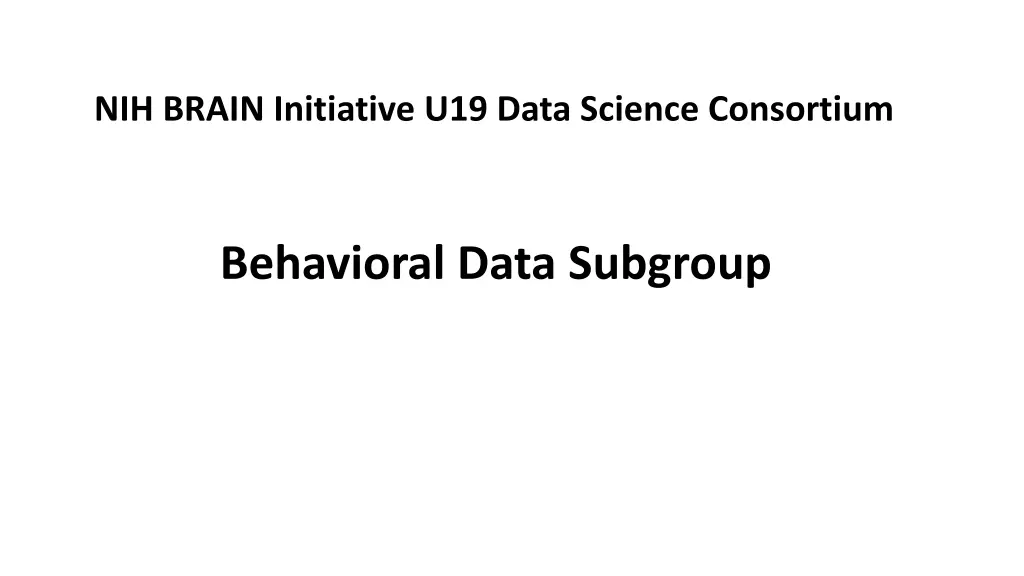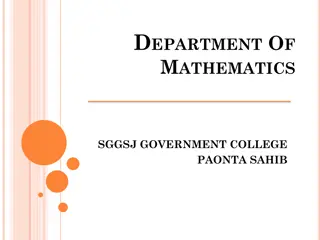
Behavioral Data Science Consortium: Diverse Approaches and Challenges
Explore the NIH BRAIN Initiative U19 Data Science Consortium's Behavioral Data Subgroup, focusing on the diversity of interests, species involved, behavioral paradigms, testing contexts, outcome measures, and associated neural/physiological data. Discover the current goals, common measures/tools/workflows, and challenges faced by the subgroup in cataloguing and sharing behavioral data science approaches. Dive into the world of pupil/eye tracking, video tracking/analysis, learning paradigms, and basic workflows for data storage, synchronization, visualization, and analysis. Uncover the common challenges like limitations in video recordings acquisition, constraints on data storage, and the need for standardized/automated tools for data alignment and visualization.
Download Presentation

Please find below an Image/Link to download the presentation.
The content on the website is provided AS IS for your information and personal use only. It may not be sold, licensed, or shared on other websites without obtaining consent from the author. If you encounter any issues during the download, it is possible that the publisher has removed the file from their server.
You are allowed to download the files provided on this website for personal or commercial use, subject to the condition that they are used lawfully. All files are the property of their respective owners.
The content on the website is provided AS IS for your information and personal use only. It may not be sold, licensed, or shared on other websites without obtaining consent from the author.
E N D
Presentation Transcript
NIH BRAIN Initiative U19 Data Science Consortium Behavioral Data Subgroup
U19 Behavioral Data Subgroup Diversity of interests Species (Humans, Non-human primates, rats, mice, flies) Behavioral paradigms (e.g., schema and one-trial learning, sensory discrimination, locomotion, spatial navigation, working memory, social behavior) Testing contexts (e.g., head-fixed vs freely moving, conditioned vs unconditioned, single trial vs trial continuous 24 monitoring, habituation/training regimens) Discrete and/or continuous outcome measures (e.g., correct responses, reaction time, pupil dynamics, pose estimation, dyadic annotations) Associated neural and physiological data (e.g., electrophysiological, imaging, heart rate)
U19 Behavioral Data Subgroup Current Goals Catalogue behavioral data science approaches from individual labs and projects. Share expertise and data analysis tools Establish consensus guidelines for best practices for behavioral data acquisition, annotation, curation and sharing (raw data to meta data) across diverse species, tasks, measures and experimental contexts Initiate development of Big Data strategies to facilitate comparative research and generalization of behavioral data across species
U19 Behavioral Data Subgroup Common measures, tools and/or workflows Pupil/eye tracking in flies, mice, rats, non-human primates and humans (e.g., iScan/iLink, Dickinson custom) Video tracking and analysis: (e.g., LEAP (Leap Estimates Animal Pose), Bonsai, DeepLabCut, JAABA (Janelia Automated Animal Behavior Annotator) , ROS (Robot Operating system), Ebbesen social tracking) Learning paradigms (discrimination-choice learning), spatial orientation or navigation Basic workflows including needs for archival and flexible data storage, data synchronization and alignment across multiple measures and sample rates, data selection and processing, visualization and analysis, code sharing (Github), data curation, annotation and sharing (e.g., DataJoint, Mendeley Data, Jupyter Notebook)
U19 Behavioral Data Subgroup Common challenges Limits to acquisition of video recordings (IACUC and Freedom of Information Act) Constraints on data storage (cost, speed, reliability) Standardized (by comparison) and automated tools for alignment and visualization of multiple data streams (e.g., DataJoint). Decisions regarding appropriate segmentation of behavior into flow of discrete units Translation/generalization of behavior across species, tasks, measures and contexts






















